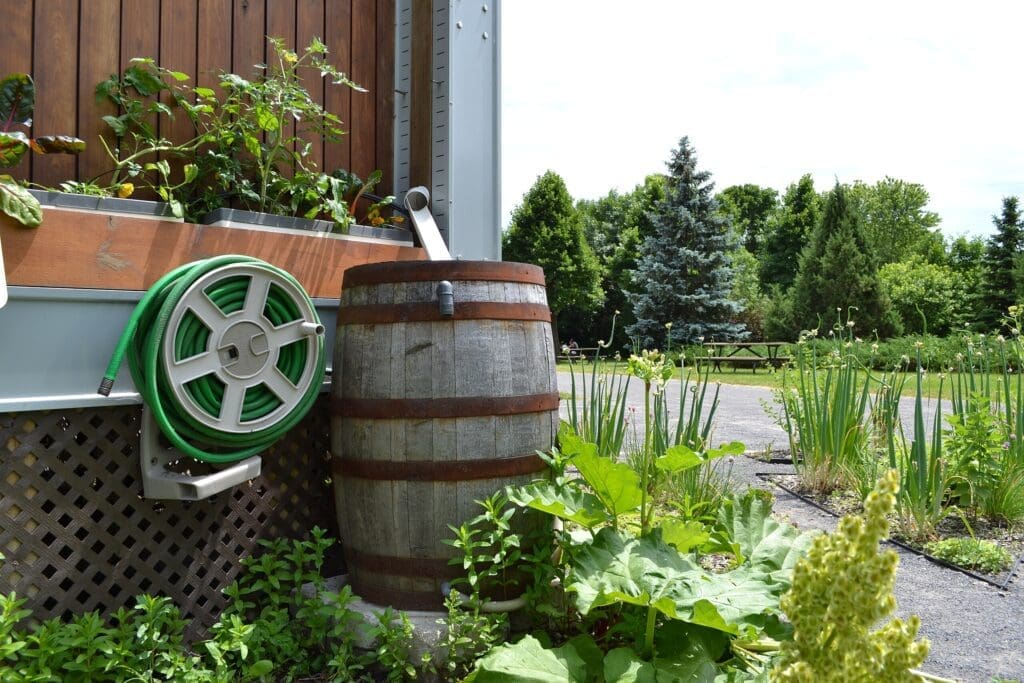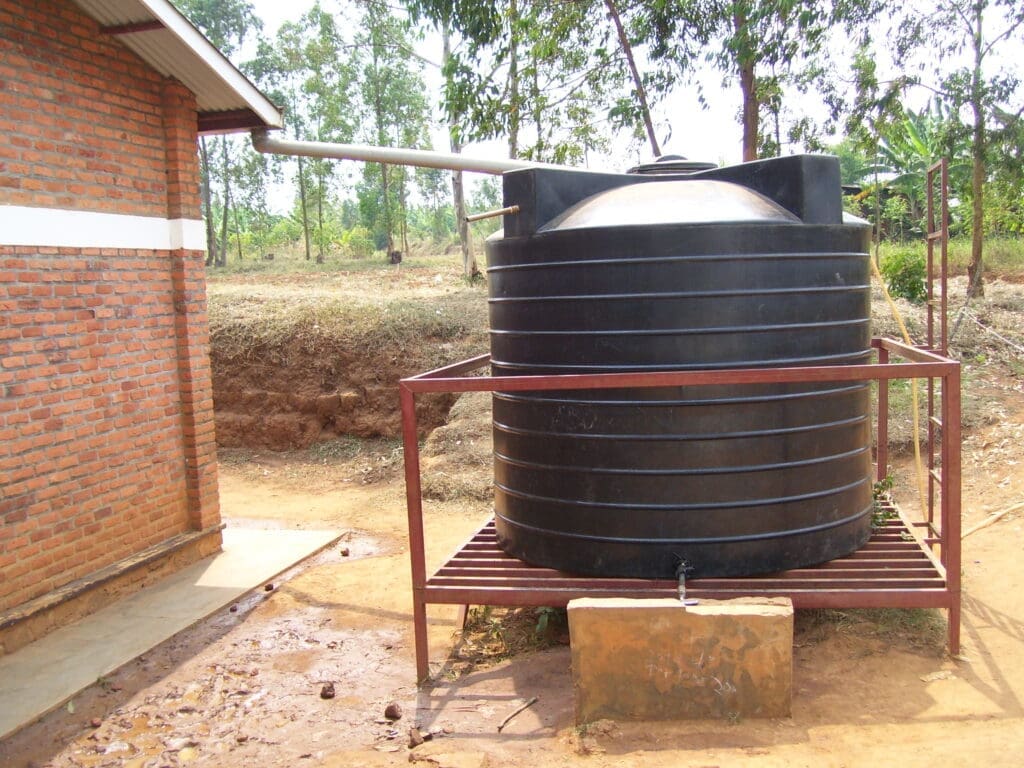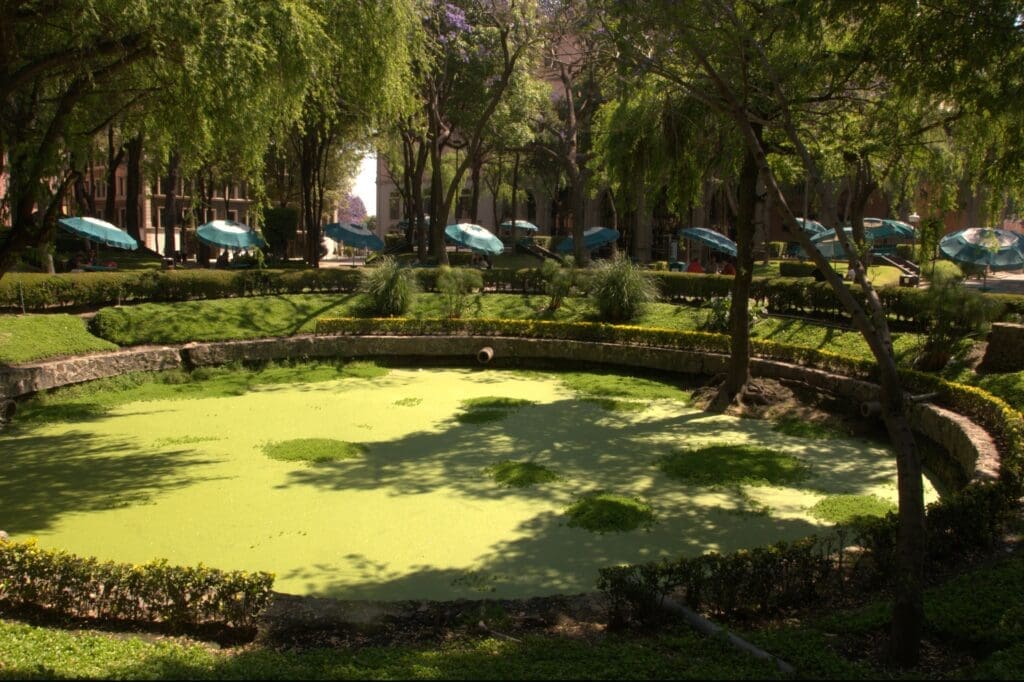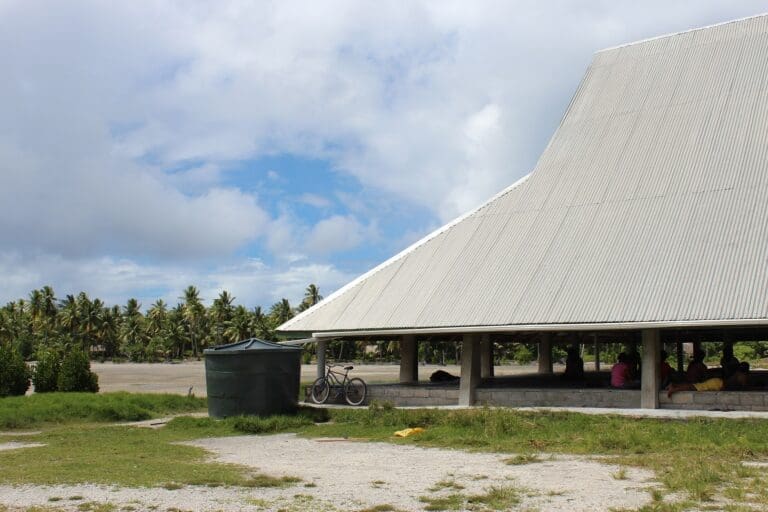In Solarpunk cities, rain is not merely a nuisance to be channeled into drains—it becomes a valuable resource. By collecting water from rooftops and paved surfaces, or, even solar panels, urban areas can transform every downpour into stored local supply. Installing gutters, downspouts, filtration systems, and storage tanks allows cities to retain water that would otherwise disappear into sewers within minutes.

How It Works: Systems and Scale
Rainwater harvesting intercepts rainfall from roofs or plazas, conveys it via gutters or swales, filters debris, and stores it in tanks or cisterns. The collected water can then be used for irrigation, cleaning or even potable uses with proper treatment. For example, a 100 m² roof receiving an annual rainfall of about 800 mm—the level typical of Mexico City[1] or Rome[2]—could collect roughly 80 m³, or 80,000 liters, of usable water each year. Scaled across a neighborhood, that capacity becomes transformative. The essential components include the catchment surface, conveyance (gutters, pipes), debris filtration, storage tanks and controlled release or usage. Properly designed overflow systems feed water back into the ground through permeable paving or bioswales.
Technical Considerations and Design
Storage sizing determines how effective the system will be. A general rule is to size a tank to hold about one month of average rainfall for the given roof area. Coming back to the example above, for a 100 m² roof with 800 mm of annual rainfall, an 8–11 m³ tank is appropriate. Integrating rainwater harvesting with permeable paving, green roofs and vegetation—the so-called Sponge City approach—amplifies results. In China’s Sponge City program,[3] municipalities aim to capture and reuse at least 70 % of rainfall locally. This model turns stormwater from a disposal problem into a local resource that supports biodiversity, reduces flooding and replenishes groundwater.

Urban Benefits
Rainwater harvesting strengthens water security by reducing dependence on distant reservoirs or imported supply. In drought-prone regions, it provides a buffer during dry periods. Capturing rain where it falls also prevents runoff and flooding, easing the load on urban drainage networks. Cities save infrastructure costs as fewer resources are spent on expanding stormwater pipes and treatment plants. Beyond the utilitarian value, harvested rain supports urban gardens, community agriculture and rooftop greenery that enhance livability and mitigate heat islands. The visible presence of these systems—cisterns, rooftop tanks, lush gardens—embodies the Solarpunk ideal of decentralized resilience and cooperation between people and the environment.
Global Community Examples
In Chennai, India, neighbourhood groups and schools began installing rooftop rainwater harvesting systems after the city’s severe water shortages in the early 2000s. The initiative was so successful that it became mandatory for new buildings. Today, more than 90 % of buildings in Chennai include such systems, recharging local aquifers and reducing dependence on external reservoirs.[4]
In Melbourne, Australia, the local government supported “Raingarden” projects in which residents collect and filter rainwater in garden basins connected to public green spaces. This initiative has diverted millions of litres of runoff from the city’s stormwater network, improving both water quality and urban cooling.[5]
In São Paulo, Brazil, community groups in the district of Vila Mariana turned underused courtyards into shared rainwater collection hubs, combining storage tanks with community gardens. Supported by local NGOs, these efforts have provided supplemental irrigation water during drought periods and reduced flood incidents.[6]
In Singapore, solar panels and rainwater harvesting are combined on a large flat surface. The panels generate electricity while their sloped surfaces channel rain into a filtration and storage system that supplies greywater for cleaning and landscaping. This integrated design captures over 200,000 liters of rainwater annually and produces renewable energy simultaneously—a model of efficient, space-saving urban sustainability.[7]
Each of these examples shows how citizens, when supported by sensible policy and local design innovation, can build self-sustaining micro-water systems. That’s the Solarpunk spirit: decentralized resilience rather than dependence on centralized, resource-intensive infrastructure.

Pros and Cons
Pros: Rainwater harvesting offers tangible environmental and economic benefits. It conserves potable water by substituting non-potable sources for irrigation and sanitation, reducing municipal demand by up to 40 %.[8] It also lessens the risk of flooding and erosion, especially in dense cities with large impervious surfaces. By reusing stormwater, communities can recharge groundwater and mitigate urban heat. Aesthetic and psychological benefits also arise—residents feel directly connected to ecological cycles when they see water being collected, stored and used locally.
Cons: Initial costs and maintenance requirements remain the largest barriers. Installing tanks, piping and filtration adds to construction budgets, and in existing buildings retrofits can be logistically difficult. Poorly maintained systems can breed mosquitoes or develop biofilm that degrades water quality.

Pathway to a Solarpunk Water Future
In the Solarpunk vision—where communities act locally and design with ecology—rainwater harvesting is not an accessory but core urban infrastructure. Municipal incentives, revised building codes and collective initiatives can help make it universal. Cities could require new developments to capture a minimum percentage of rainfall or offer tax credits for installed cisterns. When every building becomes a micro-water station, storing and reusing the rain that falls on it, the city becomes a living watershed.
By replacing “grey” infrastructure of drains and pipes with “blue-green” systems that capture, store and reuse rain, Solarpunk cities harmonize technology and ecology. Every downpour becomes an opportunity, every roof a collector, and every neighborhood a step toward a water-secure, climate-resilient future.
Sources:
[1] https://en.wikipedia.org/wiki/Mexico_City
[2] https://en.climate-data.org/europe/italy/lazio-416/
[3] https://en.wikipedia.org/wiki/Sponge_city
[4] https://r10.ieee.org/indiacouncil/wp-content/uploads/sites/149/2018/08/p30-p34.pdf
[5] https://www.melbourne.vic.gov.au/raingardens
[6] https://www.resilience.org/stories/2015-11-13/rainwater-harvesting-in-sao-paulo-brazil/
[7] https://www.edb.gov.sg/en/business-insights/insights/singapore-opens-first-solar-farm-with-integrated-rainwater-harvesting-system.html
[8] https://iwaponline.com/jwrd/article/15/3/319/108983/Rainwater-harvesting-potential-and-impact-on








